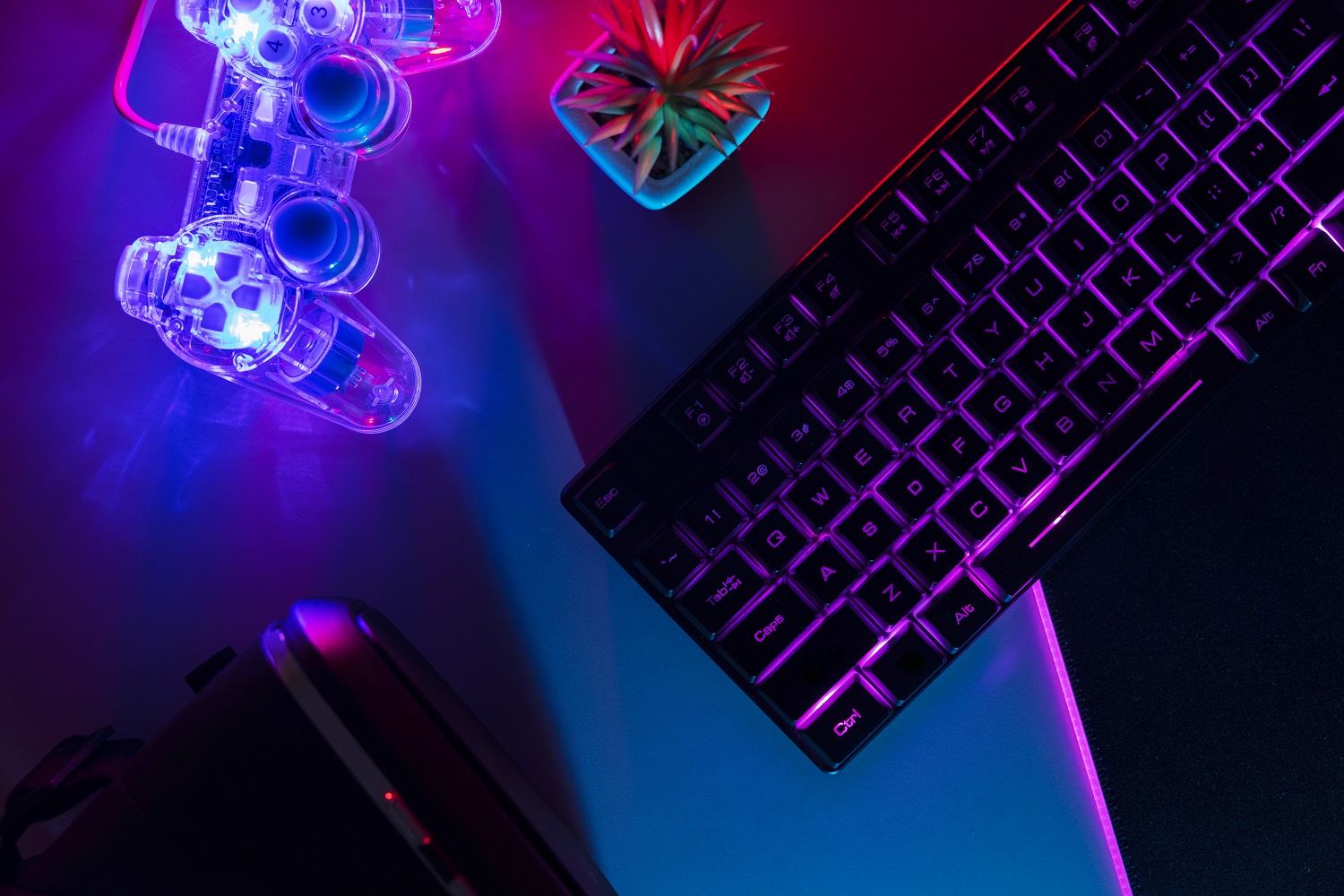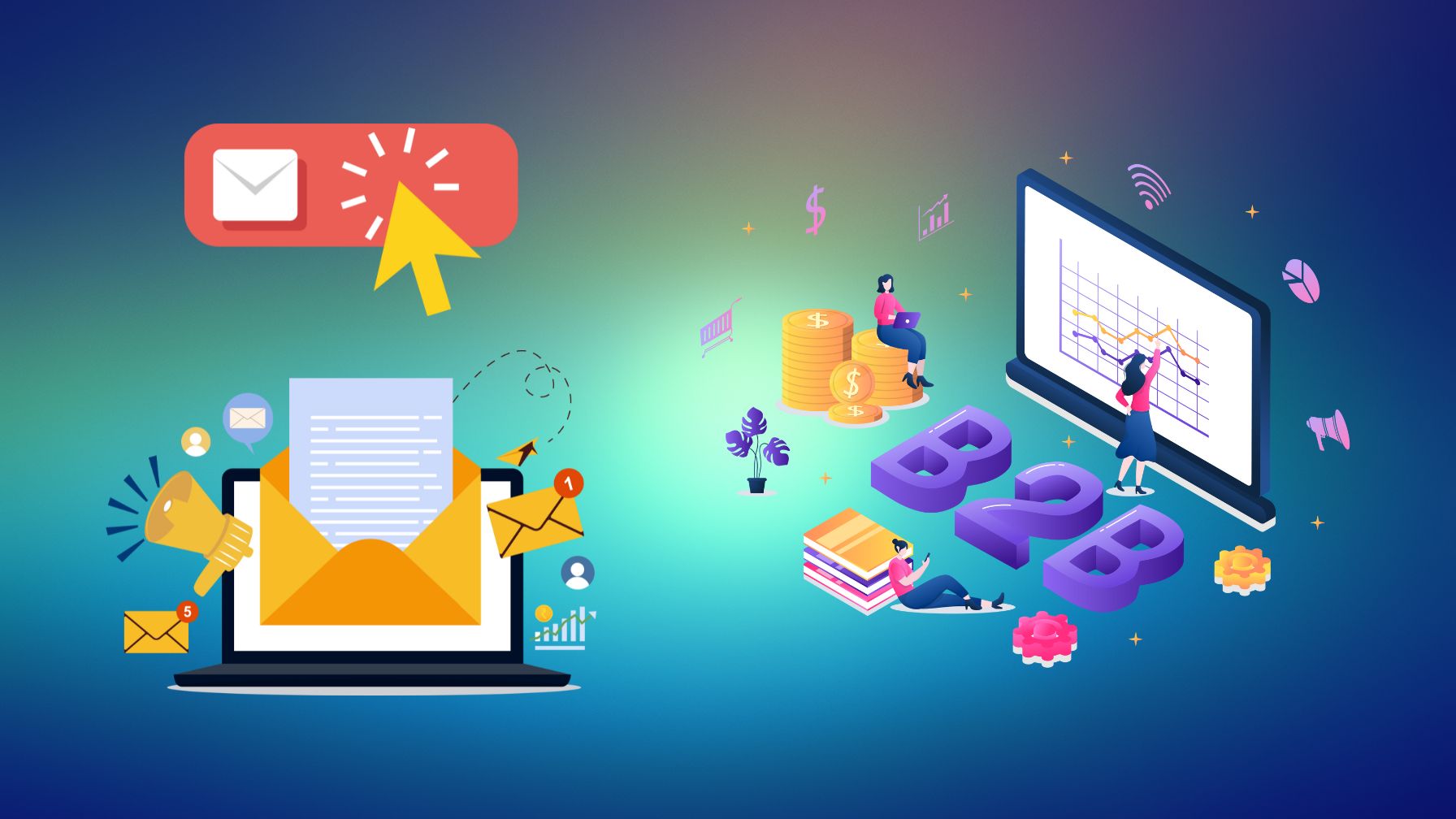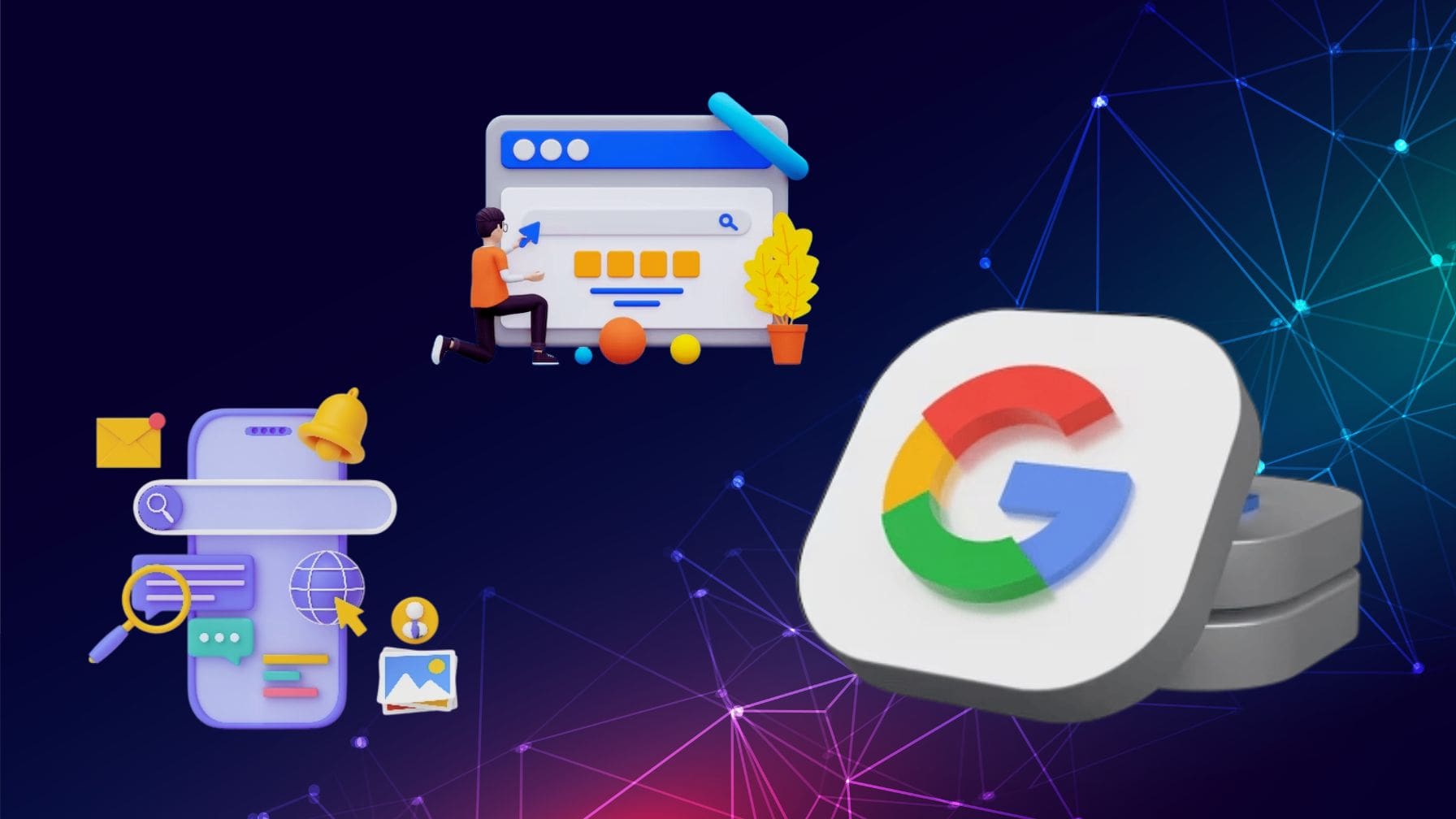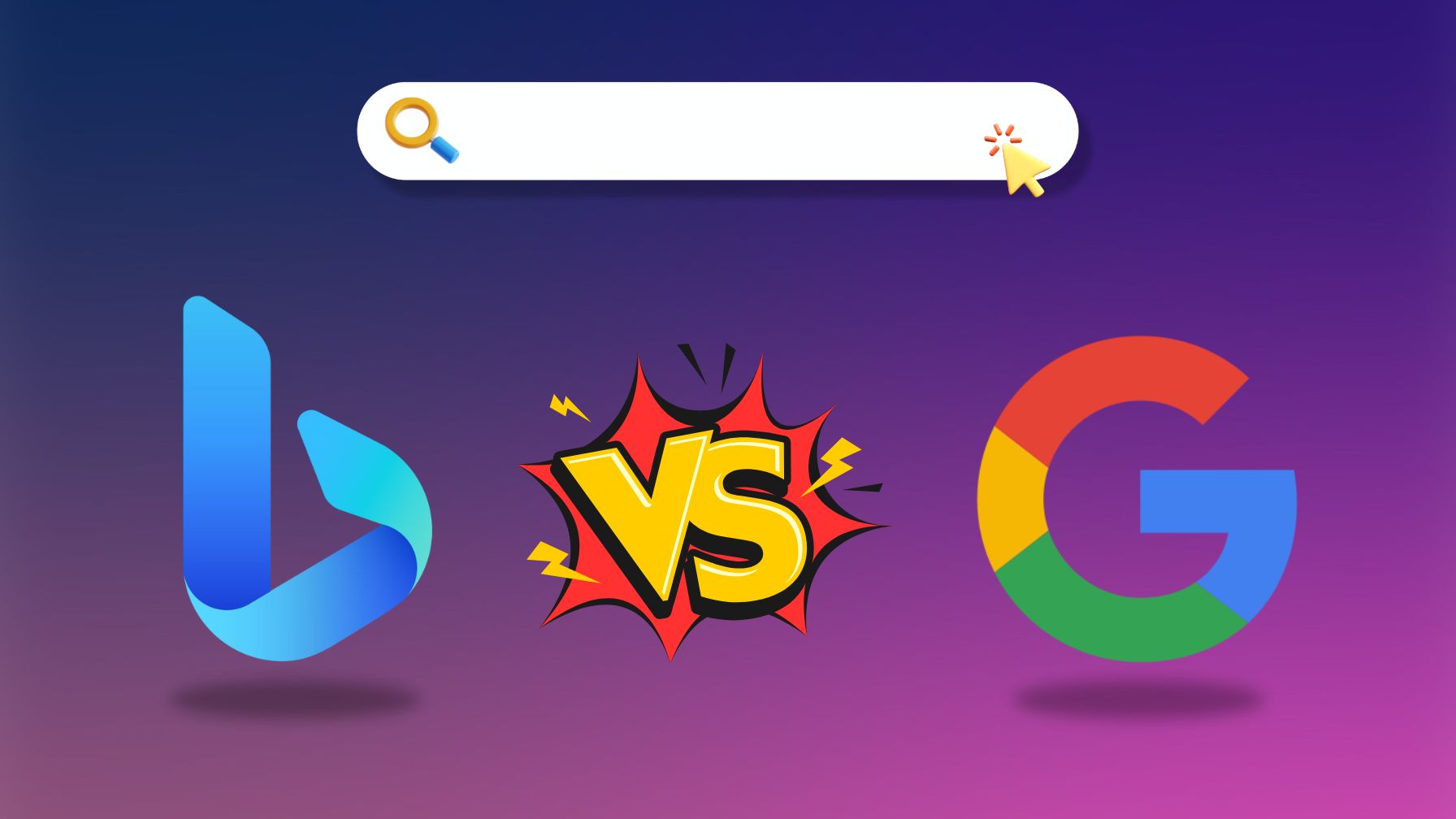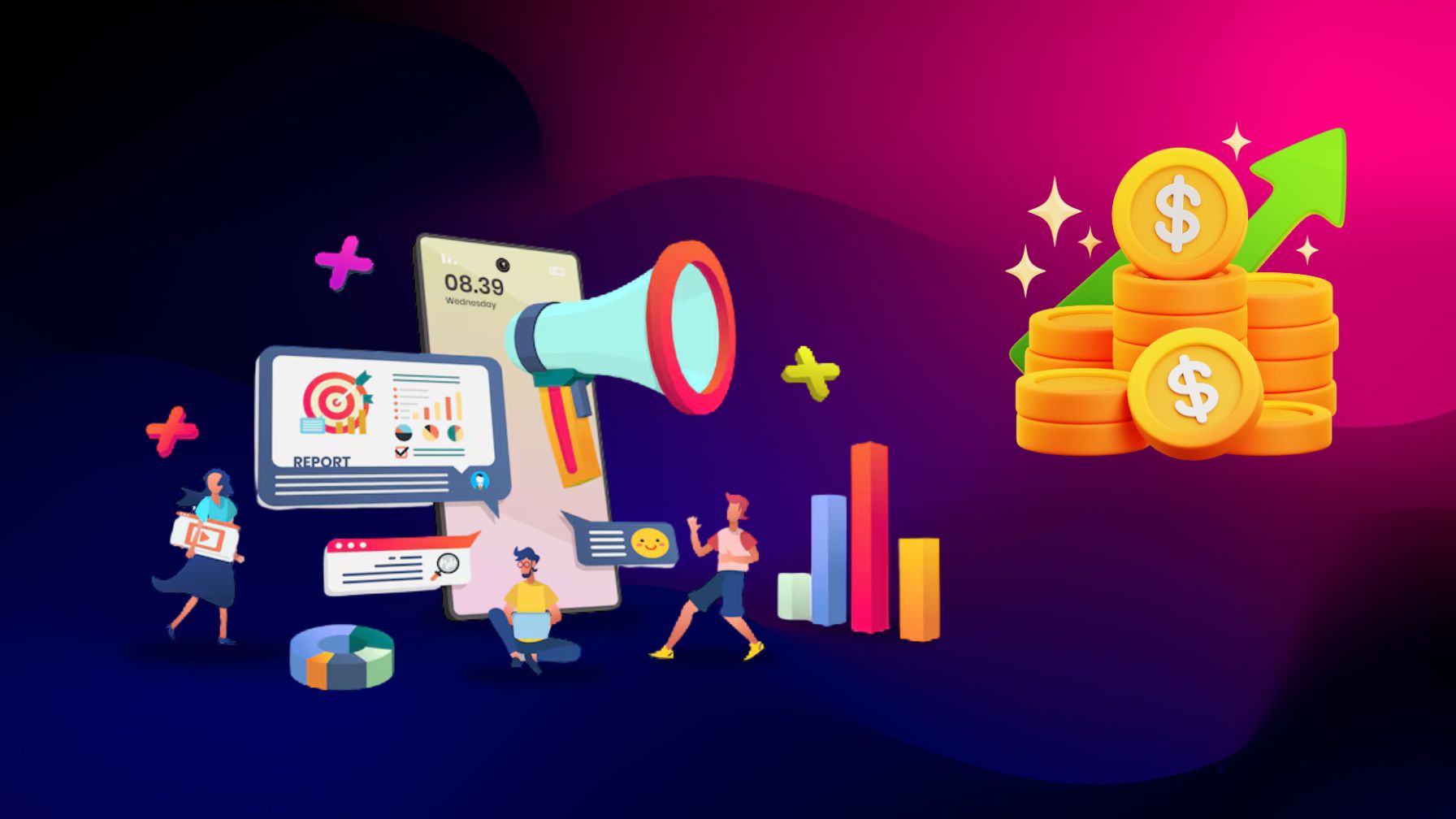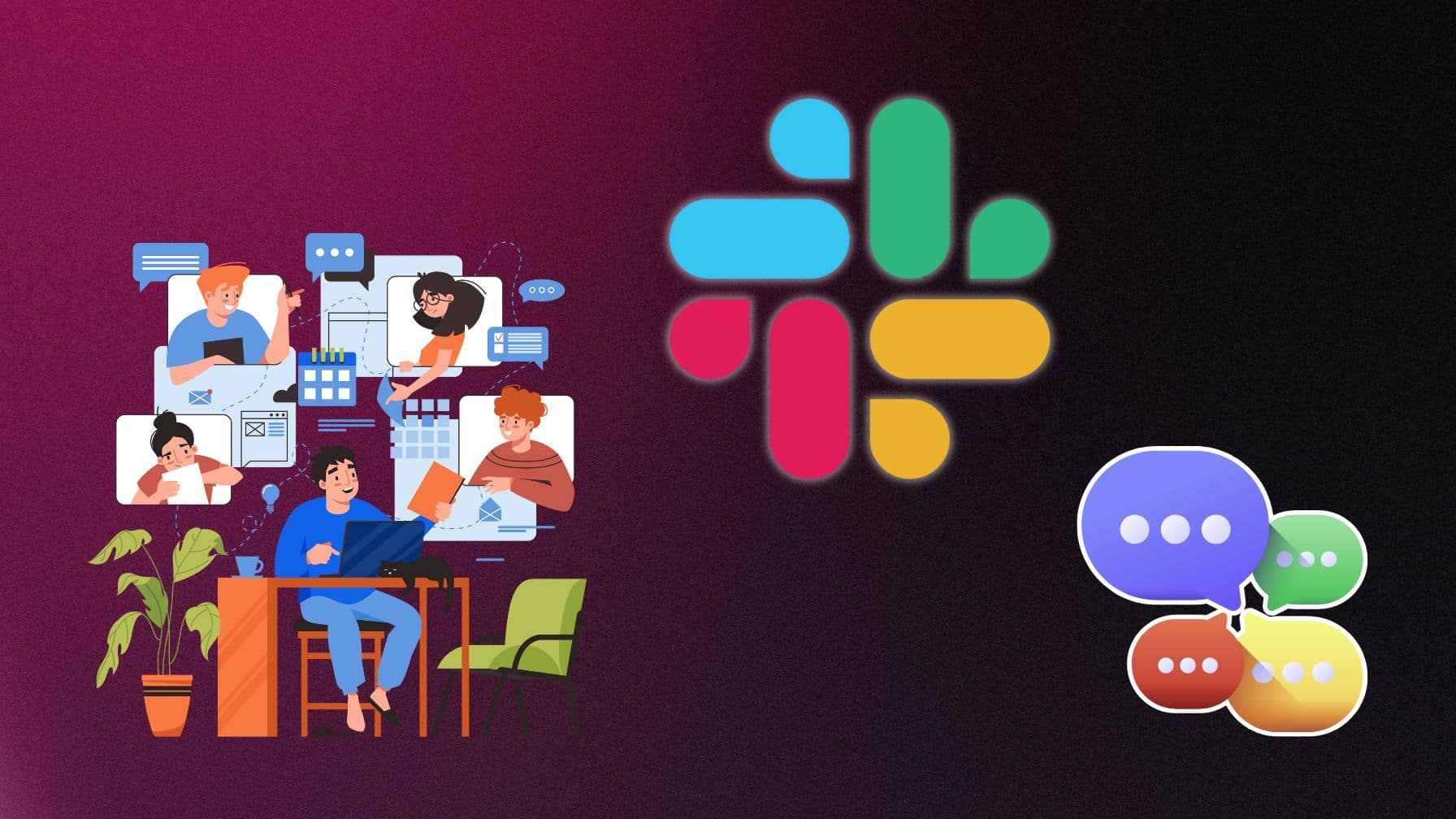WHAT WE HAVE ON THIS PAGE
- Editor’s Choice
- Internet Addiction Risk by Age Group
- Global Prevalence of Internet Addiction
- Gender Differences in Internet Addiction
- Negative Social Media Effects on US Teenagers by Emotional Well-Being
- Internet Addiction Among Students and Teenagers
- Regional and Country-Specific Internet Addiction Rates
- Smartphone Addiction Habits in the UK
- Common Symptoms and Behavioral Indicators
- Internet Addiction and Mental Health Correlations
- US Average Adolescent Screen Time
- Workplace Productivity and Internet Overuse
- Internet Gaming Disorder
- Daily Social Media Usage Among Children
- Treatment and Recovery Rates
- Emotional Effects of Social Media on Teens
- Recent Developments
- Conclusion
- Sources
In the quiet moments between meetings, on the bus ride home, or just before bedtime, many of us instinctively reach for our phones. What starts as a quick scroll through headlines or social feeds often spirals into hours of unintentional browsing. This growing pattern reflects a modern struggle: internet addiction. While the term once sounded like an overreaction, 2025 data confirms that it’s now a global health concern, reshaping how we interact, work, and even think. This article dives deep into the latest internet addiction statistics to bring clarity to a challenge that’s affecting individuals across age groups, regions, and professions.
Editor’s Choice
- 64.5% of the global population now has regular internet access, increasing the risk of compulsive online behavior.
- 21.8% of internet users worldwide exhibit signs of moderate to severe internet addiction in 2025.
- The average screen time for US adults reached 7.6 hours per day in 2025, with social media accounting for nearly 2.8 hours of that time.
- 32% of US teenagers admitted they feel anxious when they are not connected to the internet.
- 42.7% of online gamers in Asia reported losing sleep due to prolonged gameplay sessions.
- Smartphone usage driven by app-based services contributes to 71% of reported digital overuse cases.
- In a 2025 meta-study, 57% of individuals seeking help for internet addiction also reported symptoms of anxiety or depression.
Internet Addiction Risk by Age Group
- Teens aged 13–17 face the highest risk of internet addiction, with a staggering 73% affected.
- The 18–24 age group follows closely behind at 71%, highlighting high vulnerability among young adults.
- Individuals aged 25–34 have a 59% risk, showing continued high dependency during early adulthood.
- The risk slightly declines to 54% among those aged 35–44, though still significant.
- For the 45–54 age group, the risk drops to 40%, reflecting a shift in internet usage habits.
- Those aged 55–64 show a slightly lower risk at 39%, suggesting less dependence on the internet.
- Interestingly, the 64+ age group shows a 44% risk, indicating a modest rebound in usage among seniors.
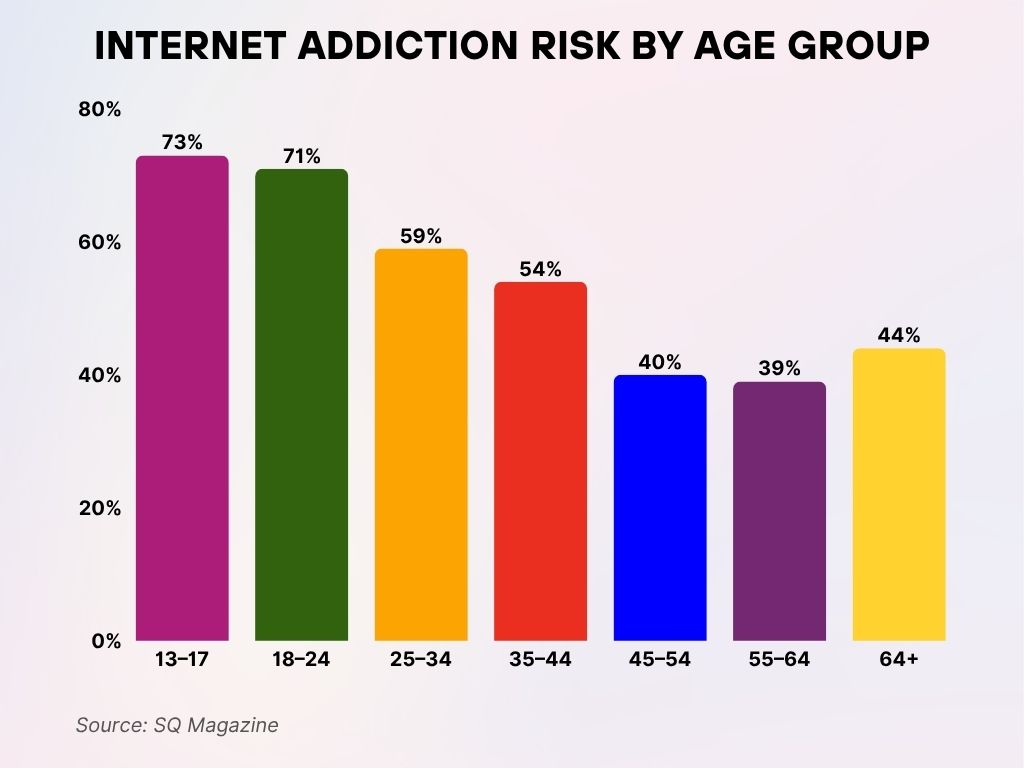
Global Prevalence of Internet Addiction
- In 2025, global internet addiction prevalence is estimated at 17.9%.
- The Middle East and Southeast Asia reported the highest prevalence rates, with 31.4% and 29.2%, respectively.
- Western Europe recorded the lowest regional rate at 8.7% in 2025.
- Internet addiction in North America stands at 15.2%, showing a steady upward trend over the last five years.
- South America saw a sharp rise in reported cases, now at 22.6%, attributed partly to increased mobile broadband penetration.
- In sub-Saharan Africa, internet addiction remains comparatively lower at 6.4%, though usage trends are rising.
- China’s national rate reached 24.9%, linked with heavy reliance on mobile platforms and social commerce.
- India reported 21.1% of users exhibiting compulsive browsing and social media use.
- Japan, with its aging population, reported a unique rise among adults aged 45+, accounting for 12.3% of cases.
- Global studies indicate that 2 in 5 people with internet addiction have no awareness of their behavioral dependence.
Gender Differences in Internet Addiction
- Males remain slightly more affected, with 19.6% showing signs of internet addiction versus 16.3% of females.
- Adolescent boys reported 32.8% addiction rates, mostly linked to online gaming and streaming.
- Girls in the 13–19 age range showed 24.1% addiction rates, with social media as the leading activity.
- Males are 2.1x more likely than females to develop internet gaming disorder.
- Women aged 30–45 report higher stress-linked internet use, with 13.5% meeting mild addiction criteria.
- Men aged 20–35 are more susceptible to work-related digital overuse, with 22% reporting daily compulsive checking behavior.
- Female internet addiction is strongly associated with social comparison anxiety, especially on image-based platforms.
- 26% of women surveyed in 2025 stated they spend more time online than they intended “almost every day.”
- In married couples, male partners were 17% more likely to use digital platforms as a form of escapism.
- Gender-neutral interventions in therapy saw higher success rates (up to 61%) compared to gender-specific treatments.
- 70% of teens with low social-emotional well-being feel left out or excluded when using social media, compared to just 29% of teens with high well-being.
- 43% of emotionally struggling teens have deleted posts due to too few likes, while only 13% of emotionally healthy teens did the same.
- 43% of teens with low well-being feel bad if no one engages with their posts, versus just 11% of teens with high well-being.
- 35% of low well-being teens report having been cyberbullied, in contrast to 5% among their high well-being peers.
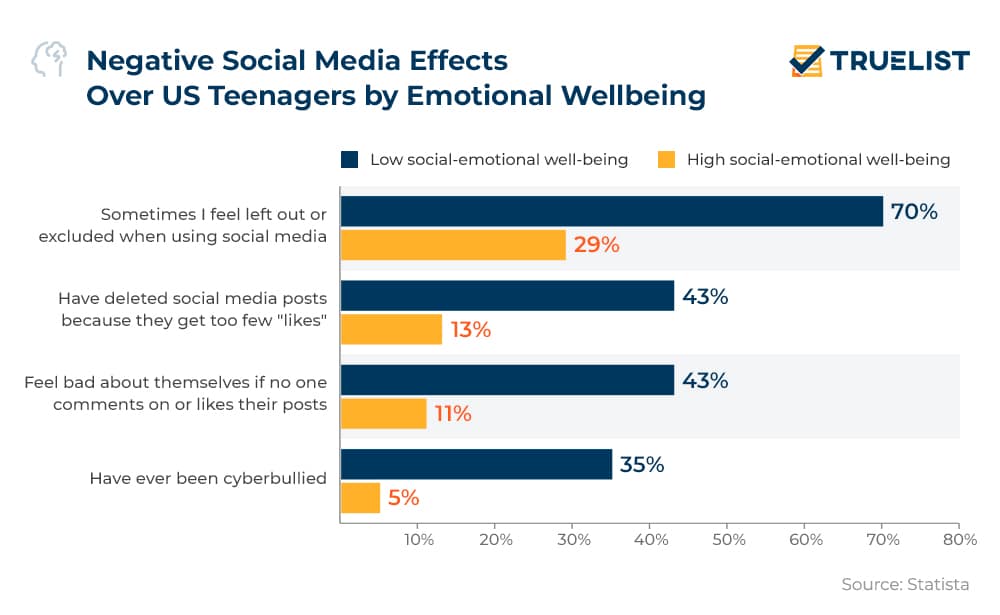
Internet Addiction Among Students and Teenagers
- In 2025, 34.9% of high school students in the US exhibited symptoms consistent with internet addiction.
- Middle school students report an addiction rate of 27.6%, primarily driven by mobile gaming and social media use.
- College students (aged 18–22) have a self-reported internet dependency rate of 31.2%.
- 88% of students said they check their phones during class, with 42% admitting it disrupts their ability to focus.
- 51% of surveyed teenagers reported mood changes when unable to access the internet.
- Excessive internet use correlates with lower GPA scores, with addicted students scoring 0.6 points lower on average.
- Students addicted to gaming or streaming platforms spend 10.2 hours daily online, nearly 3x the healthy average.
- 17% of students admitted to skipping meals or delaying sleep due to prolonged screen use.
- Adolescents using their phones after 10 p.m. showed 45% higher rates of insomnia.
- In 2025, 25.3% of teenage females cited social media as a primary source of anxiety and self-esteem issues.
Regional and Country-Specific Internet Addiction Rates
- South Korea maintains one of the world’s highest national addiction rates at 33.7%.
- The United States shows a national prevalence of 18.5%, with urban youth contributing significantly to the figure.
- Brazil’s reported rate increased to 23.1%, driven by the surge in mobile broadband usage in urban slums.
- Germany’s national internet addiction rate held steady at 9.4%, among the lowest in Western Europe.
- Canada reported a 15.2% national addiction rate, with provincial differences showing higher rates in Ontario and Quebec.
- Nigeria experienced a spike to 11.3%, especially among youth aged 16–25 in metropolitan regions.
- Australia’s rate stood at 16.9%, with male university students at 29.4%, the highest subgroup.
- Japan reported 14.1% national prevalence, with rising concern among adults aged 40–55.
- India recorded 22.7% in urban districts, largely due to affordable mobile data plans and digital entertainment growth.
- Russia’s reported rate climbed to 19.8%, with gaming and online forums leading behavioral triggers.
Smartphone Addiction Habits in the UK
- 54% of UK respondents never check their phones when they wake up in the middle of the night, but 17% still do it very or fairly frequently.
- 84% of people never look at their phones while driving, yet 4% still do it very or fairly frequently, raising safety concerns.
- When watching TV, 54% check their phones very or fairly frequently, showing a trend toward dual-screening.
- During work, 35% of users look at their phones very or fairly frequently, while 26% refrain completely.
- 43% of users very or fairly frequently check their phones in bed before sleep, which may disrupt sleep quality.
- While having dinner at home, 18% of users check their phones frequently, but nearly half (46%) say they never do.
- Only 11% of users check their phones frequently while eating dinner out, and 46% abstain entirely.
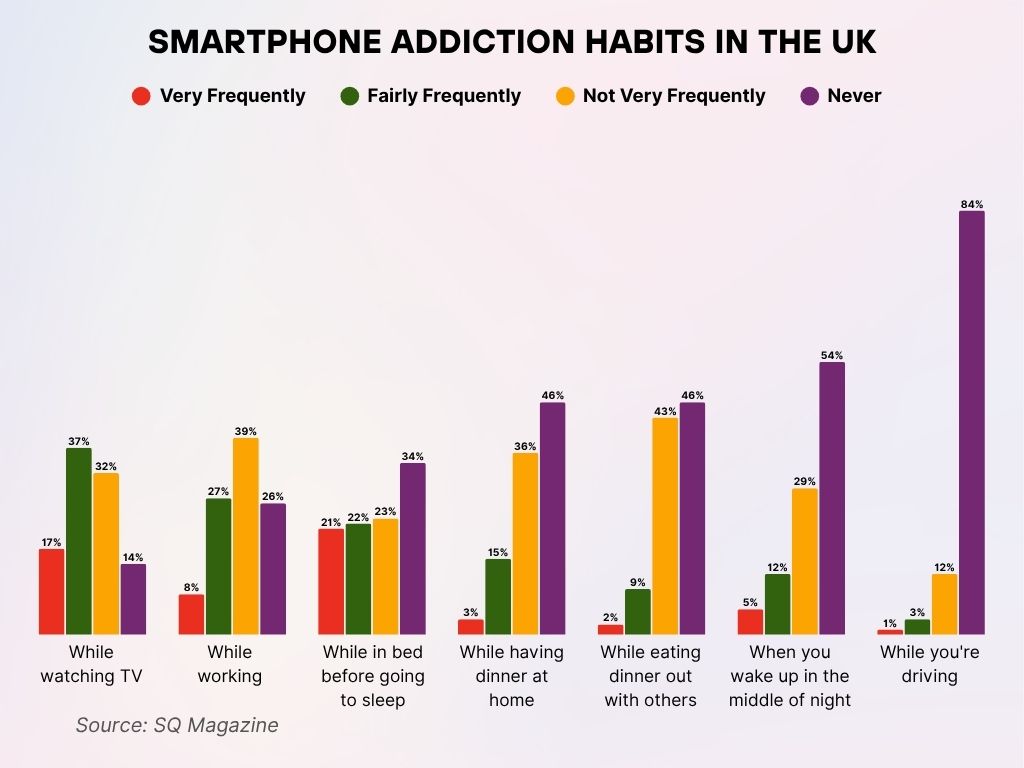
Common Symptoms and Behavioral Indicators
- 67% of people with internet addiction report compulsive checking of devices, even when not prompted.
- 44.2% of addicted users experience withdrawal symptoms like irritability and restlessness when offline.
- 58% struggle with time distortion, often losing track of hours while browsing or gaming.
- 31.5% report hiding or lying about their actual screen time from family or partners.
- Sleep disruption is reported by 72% of individuals with internet dependency, including delayed sleep onset and reduced quality.
- 36.1% of addicted users experience reduced productivity in daily life due to digital distractions.
- Mood instability is noted in 29%, especially after extended social media use or exposure to negative content.
- 48% admit they use the internet to cope with stress, boredom, or emotional discomfort.
- 19.6% reported declining personal hygiene or household responsibilities due to online preoccupation.
- In 2025, therapists observed that internet addiction behaviors now mimic compulsive disorders in 28.4% of diagnosed cases.
Internet Addiction and Mental Health Correlations
- In 2025, 62% of individuals diagnosed with internet addiction also exhibited symptoms of anxiety or depression.
- Clinical data shows 38.9% of digital addicts meet criteria for generalized anxiety disorder (GAD).
- 41.7% report experiencing increased irritability and mood swings directly tied to internet use.
- Individuals with pre-existing depression were found to be 2.8x more likely to develop compulsive online behaviors.
- Prolonged digital exposure is linked to a 34.5% increase in sleep disorders such as insomnia and delayed sleep phase syndrome.
- 19.6% of therapy patients cite internet escapism as a way to avoid real-world stressors.
- Smartphone notifications trigger measurable stress responses in 44% of users, even when the message content is neutral.
- A 2025 brain imaging study revealed that overuse of social media alters neural pathways in adolescents, especially in reward and impulse areas.
- 52% of individuals in digital detox programs reported improved mood and reduced anxiety within three weeks.
- Excessive screen use has been correlated with reduced gray matter density in the anterior cingulate cortex, an area tied to emotional regulation.
US Average Adolescent Screen Time
- 51% of all teenagers spend at least four hours per day on screens, averaging 4.8 hours daily.
- 62% of 17-year-olds report the highest screen time, with an average of 5.8 hours per day.
- At age 15, 52% of teens spend 4+ hours on screens, averaging 5.1 hours daily.
- 16-year-olds follow closely, with 55% spending 4+ hours, and an average of 4.9 hours per day.
- 18-year-olds average 5.0 hours, with 54% meeting the 4-hour minimum.
- Teens aged 19 and 14 average 4.5 hours daily, with 51% and 45% spending at least 4 hours, respectively.
- The lowest screen time is among 13-year-olds, at 4.1 hours per day, with 42% spending 4+ hours.
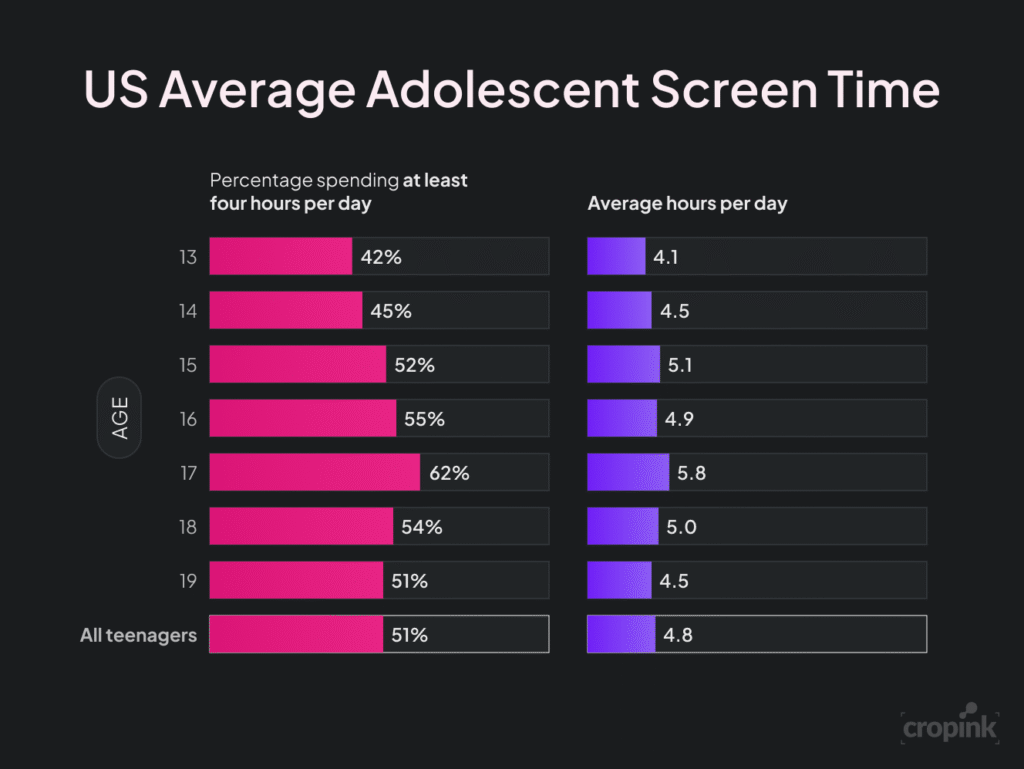
Workplace Productivity and Internet Overuse
- In 2025, 27.8% of US workers admitted to spending at least 2 hours daily on non-work internet use during office hours.
- Companies report a 14.5% drop in average productivity linked to digital distractions.
- Remote workers with flexible schedules show a 31% higher likelihood of internet overuse compared to on-site employees.
- 18.2% of employers have implemented app-blocking tools to curb time-wasting during work hours.
- A survey of 3,000 professionals found 45% check their personal social media during meetings.
- Multitasking with internet browsing led to a 26% increase in task completion time across digital roles.
- Digital workplace fatigue is reported by 57% of employees who toggle between apps more than 50 times daily.
- 22.3% of HR managers noticed a rise in disciplinary actions due to online gaming during work hours.
- Slack and similar platforms account for 11.4% of reported workday distractions, despite being productivity tools.
- Employees who took weekly digital detox breaks reported a 19.8% increase in focus and task efficiency.
Internet Gaming Disorder
- In 2025, the global prevalence of Internet Gaming Disorder (IGD) reached 6.7%.
- Adolescent males (13–18) remain the most affected group, with 18.6% showing clinically significant gaming addiction symptoms.
- Female gamers now account for 21.3% of IGD cases.
- The US reported 8.9% of its teenage population meeting the DSM-5 criteria for IGD.
- Average gaming time among addicts is 5.3 hours per day, with MMORPGs and battle royale games being most cited.
- 37% of addicted gamers reported physical issues, such as eye strain and posture-related pain.
- Parents in Asia report higher concern, with 31% seeking professional help for child gaming addiction.
- Gaming platforms with loot boxes are linked to a 58% higher likelihood of compulsive use behaviors.
- Gamers spending over $500/year on microtransactions are 3.1x more likely to exhibit addiction symptoms.
- In-game social interactions drive 42% of prolonged usage, often replacing real-world peer engagement.
- Children spend the most time on TikTok, averaging 91 minutes per day, making it the leading platform in screen time.
- Snapchat follows closely, with kids spending about 71 minutes daily checking snaps and stories.
- Instagram users among children average 41 minutes per day, showing strong engagement despite being third in ranking.
- Time spent on Reddit is much lower, with children averaging 15 minutes daily.
- Pinterest sees slightly less activity, with kids spending around 13 minutes per day browsing pins.
- Facebook ranks lowest among children, with just 10 minutes of daily usage, highlighting its decline in youth popularity.
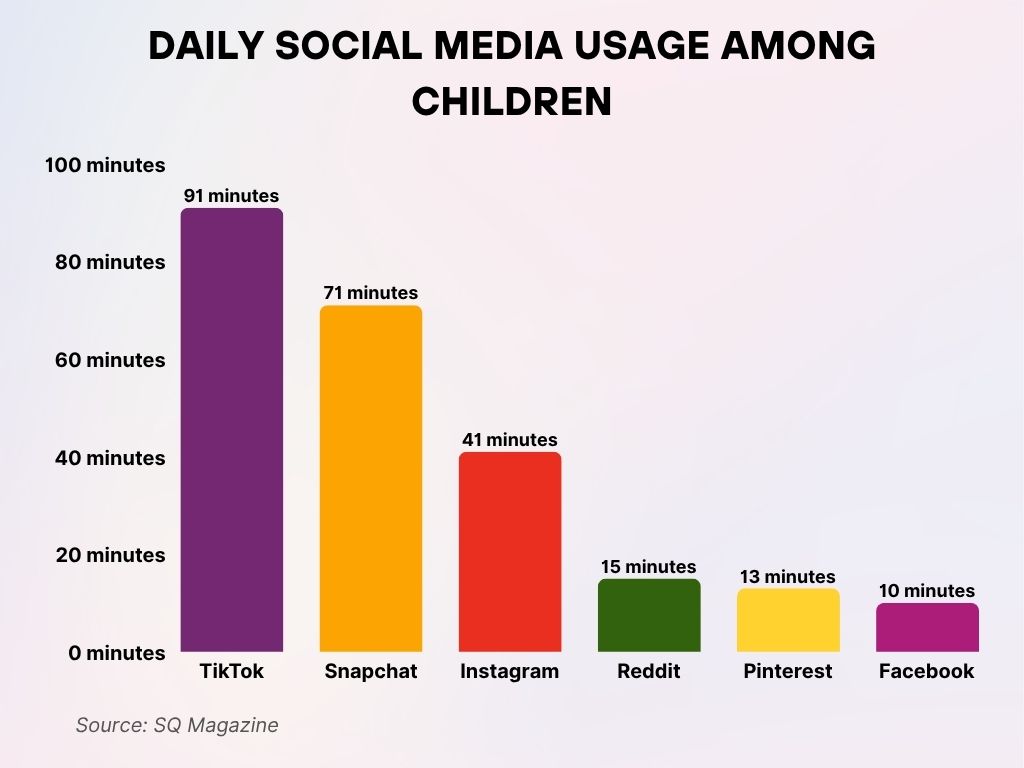
Treatment and Recovery Rates
- In 2025, 12.4% of individuals with internet addiction had sought professional therapy.
- Cognitive Behavioral Therapy (CBT) shows the highest success, with a 66% improvement rate after 12 weeks.
- In-patient digital detox programs saw 28.7% growth in enrollment compared to last year.
- 54% of recovered patients relapse within the first 6 months if not monitored or supported.
- Adolescents in family-based interventions report a 42% improvement in control over screen time.
- App-based therapy tools now support 16.3% of treated cases, providing guided daily digital behavior plans.
- Schools integrating internet wellness education report a 23% decline in student overuse behavior.
- 31.2% of recovering addicts reported improved relationships and reduced social withdrawal.
- Telehealth consultations for digital dependency increased 3x from 2022–2025.
- Combined group therapy and digital abstinence programs yielded a 74% self-reported satisfaction rate in post-treatment assessments.
- 25% of teens say social media makes them feel less lonely, the most reported positive effect.
- 21% feel more popular when using social media, while only 3% feel less popular.
- 20% report feeling more confident, whereas just 5% feel less confident.
- 18% say social media helps them feel better about themselves, compared to 4% who feel worse.
- 16% of teens feel less depressed, while only 3% say it makes them more depressed.
- 12% experience less anxiety, yet 8% feel more anxious after using social media.
- Only 3% feel more lonely due to social media, much lower than those who feel less lonely.
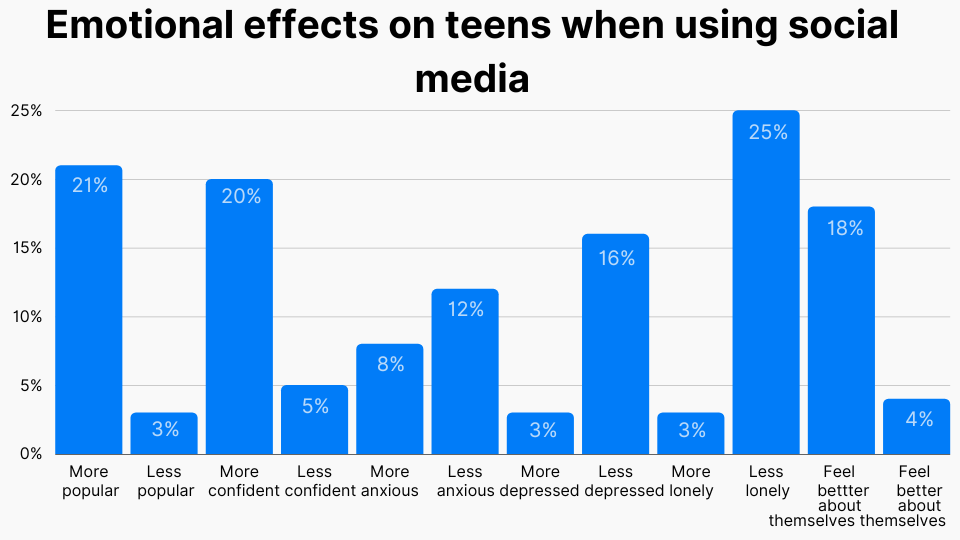
Recent Developments
- WHO updated its guidelines in 2025 to classify internet addiction as a behavioral disorder subtype with expanded diagnostic criteria.
- The US Surgeon General issued a new advisory warning on youth screen dependency, citing long-term mental health implications.
- AI-powered digital wellness apps like MindCast and PausePoint gained over 10 million active users globally.
- Several countries, including France and South Korea, introduced national “no-phone zones” in schools and public parks.
- Elon Musk-backed startup launched a neurofeedback headset to reduce compulsive online behavior in early trials.
- The European Union introduced a digital consumption tax targeting addictive app designs.
- Meta and TikTok implemented screen time alerts with behavioral nudges shown to reduce use by 12–15%.
- In 2025, digital addiction hotlines expanded to include 24/7 support for teenagers and parents in 11 countries.
- Influencer marketing campaigns around digital minimalism reached over 300 million viewers worldwide.
- Netflix, Amazon, and other streaming services began testing “focus mode” timers to combat binge-watching patterns.
Conclusion
Internet addiction is no longer a fringe issue; it’s a modern epidemic woven into the fabric of daily life. From classrooms and living rooms to boardrooms and bedrooms, its impact reverberates through mental health, productivity, and personal relationships. The 2025 data paints a clear picture: while the digital world brings immense benefits, unchecked use carries serious risks. By recognizing the patterns and supporting evidence-based interventions, individuals and institutions alike can take meaningful steps toward healthier, more balanced online lives.
Sources
- https://pubmed.ncbi.nlm.nih.gov/40297375/
- https://www.addictioncenter.com/behavioral-addictions/internet-addiction/
- https://journals.sagepub.com/doi/10.1177/20552076251336940
- https://virtual-addiction.com/technology-addiction-statistics-2025/
- https://www.mdpi.com/2076-328X/15/2/116
- https://www.jmir.org/2025/1/e59656

